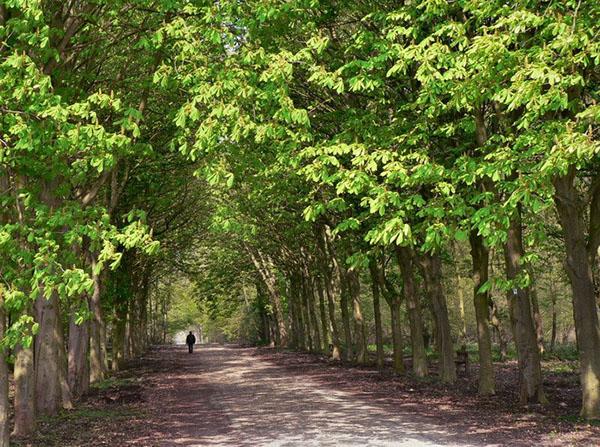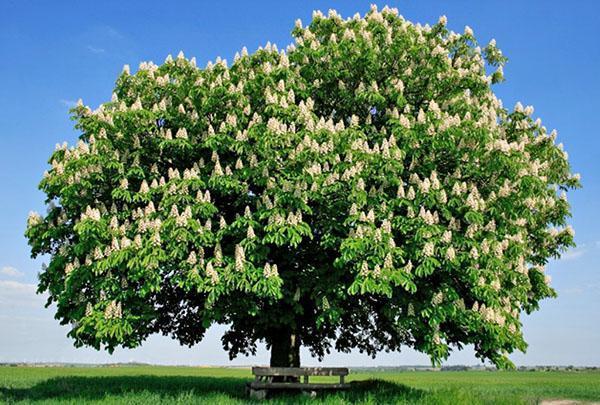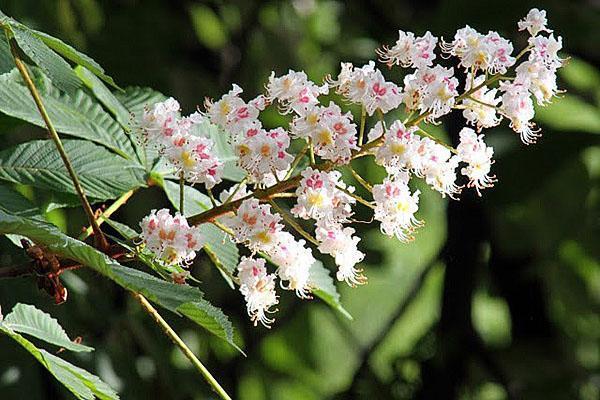Spectacular exhibit in landscape design - chestnut tree
 City squares and street alleys are unthinkable without one luxurious specimen. It is the majestic chestnut tree that takes pride of place in the landscape design of many parks. They resemble powerful giants guarding the royal cortege. Such a presentable view pleases the eye of visitors for many months. Moreover, the fruits of these members of the Cedar family are tasty and healthy. These are just some of the reasons why every gardener should expand the range of his garden with chestnut trees. The description of this perennial plant is worthy of a separate literary work. Read about horse chestnut!
City squares and street alleys are unthinkable without one luxurious specimen. It is the majestic chestnut tree that takes pride of place in the landscape design of many parks. They resemble powerful giants guarding the royal cortege. Such a presentable view pleases the eye of visitors for many months. Moreover, the fruits of these members of the Cedar family are tasty and healthy. These are just some of the reasons why every gardener should expand the range of his garden with chestnut trees. The description of this perennial plant is worthy of a separate literary work. Read about horse chestnut!
Some sources say that his homeland is Europe, while others are Australia. However, there are between 14 and 30 varieties in the world. Most of them can be found in China, Japan, North America and European countries.
Without the slightest flaw

- inflorescences are presented in the form of pyramidal candles (each up to 15 cm in length);

- flowers of a cream shade with pinkish spots and an oblong antennae in the center;
- the leaves are collected in luxurious fans (5-7 in one bunch), which are arranged spirally on the shoots;
- oblong leaves (10-20 cm) of dark green color have a serrated edge and resemble the tip of a medieval spear in shape;

- a dense ovoid / rounded crown grows up to 20 meters wide;

- brown with a glossy coating, nuts are hidden by a thorny shell, which splits into four parts when ripe or strong impact;

- the lower part of the trunk is exposed over time, and the tree takes on a gorgeous look.

These perennial plants love the sun so much that they grow up to 15-30 meters. Of course, such a result can only be expected after several decades. In this regard, many are interested in how long the chestnut tree grows. It is worth knowing that in 12 months the trunk of this giant increases by 30-50 cm. Therefore, by the fourth year of its existence, its growth will be about 1 meter. At the same time, the tree will be able to meet the 10th spring of its "life" with charming flowering and luxurious fruits.
A powerful root system and dense bark allows the chestnut to withstand severe frosts. At the same time, trees adapt to different types of soil. Nevertheless, it is better for them to choose non-saline, well-drained and moist soils.
Read also:how to fry chestnuts in a pan - step by step recipe with photo.
Three nuts for Cinderella
 An ordinary brown fruit can grow a beautiful and powerful chestnut tree. Planting and caring for his seedling at home is very simple, but they have some subtleties. Gardeners know two options for nut germination: autumn and spring. At the same time, you need to harvest after the fruits fall to the ground.
An ordinary brown fruit can grow a beautiful and powerful chestnut tree. Planting and caring for his seedling at home is very simple, but they have some subtleties. Gardeners know two options for nut germination: autumn and spring. At the same time, you need to harvest after the fruits fall to the ground.  It is necessary to choose hard nuts with a perfectly flat edge and without damage. It must be stratified before planting in the fall. For this you need:
It is necessary to choose hard nuts with a perfectly flat edge and without damage. It must be stratified before planting in the fall. For this you need:
- collect wet sand into the container;

- do not bury the fruit very deeply in it;
- leave for 10 days in a cool place;
- land on a plot of land that is moderately warmed by the sun.
 If the farmer plans to plant for the spring season, then the container with sand and nuts must be stored in the basement / refrigerator throughout the winter. Some people advise to bury this container somewhere in the garden.
If the farmer plans to plant for the spring season, then the container with sand and nuts must be stored in the basement / refrigerator throughout the winter. Some people advise to bury this container somewhere in the garden.
However, you cannot do without losses. If the gardener wants to plant only one specimen, he should prepare three or more nuts. Extra seedlings can always be donated to neighbors.
Spring planting boom
 7 days before disembarkation, which may fall at the end of February or March, a container with valuable genetic material must be taken out of the basement. Over the next 5 days, the fruits are soaked in warm water. In this case, the liquid should be constantly changed, because it can deteriorate. Thanks to this “spa procedure”, the skin becomes softer and the embryo wakes up. When a white sprout appears, the chestnut can be planted in a small pot of soil, taking into account the following wishes:
7 days before disembarkation, which may fall at the end of February or March, a container with valuable genetic material must be taken out of the basement. Over the next 5 days, the fruits are soaked in warm water. In this case, the liquid should be constantly changed, because it can deteriorate. Thanks to this “spa procedure”, the skin becomes softer and the embryo wakes up. When a white sprout appears, the chestnut can be planted in a small pot of soil, taking into account the following wishes:
- the volume of the landing container should not exceed 500 ml;

- the soil must be sufficiently moistened;
- the fruit should be placed in the ground, but not very deep (3-5 cm), otherwise it will either dry out or not germinate;
- water periodically.
 After half a month, the gardener can already admire the first shoots. When the danger of night frosts has passed, and this is the second half of May, then the seedling can be transferred to its "permanent residence".
After half a month, the gardener can already admire the first shoots. When the danger of night frosts has passed, and this is the second half of May, then the seedling can be transferred to its "permanent residence".
It should be borne in mind that the chestnut tree is a real titanium. Therefore, the distance between seedlings must be increased to 3 meters. As a result, the crown of each of them will be thicker, the flowering period will be longer, and the fruits will be tastier.

Secret technique
 Of course, there is a lot of debate about when is the best time to plant these trees. However, each of these options has its advantages. Autumn “natives” sprout faster. Still, spring specimens are characterized by intense growth, frost resistance and a healthier appearance. Among other things, the planting process itself plays an important role in this matter. Here's what the experts advise in this regard:
Of course, there is a lot of debate about when is the best time to plant these trees. However, each of these options has its advantages. Autumn “natives” sprout faster. Still, spring specimens are characterized by intense growth, frost resistance and a healthier appearance. Among other things, the planting process itself plays an important role in this matter. Here's what the experts advise in this regard:
- Carefully remove the seedling roots from the container. The land ball should be up to 50 cm in diameter.
- Dig a hole 2 times the size of the root system. At its bottom, it is necessary to lay out several layers of crushed stone / pebbles, which will serve as a drainage device. The optimum height of such a "foundation" is 10 cm.
- Prepare a substrate from sand, humus and black soil (1: 1: 2). All this must be mixed with slaked lime (0.5 kg). At the same time, it is recommended to apply phosphate-potassium fertilizers to each hole.
- 1/2 of the prepared substrate is poured onto the drainage and filled with water. Then the seedling is settled, which should be covered with earth in several passes. After tamping the soil near the root collar, the tree needs to be watered.
- The seedling is more quickly accepted if the ground near it is covered with mulch (humus, foliage or sawdust) or paper bags.

- A small fence is erected around the trunk. In strong winds, it is important to secure the young tree with ropes.
Don't forget about the importance of feeding. It is held both in spring and autumn. In the first case, it is diluted urea or mullein (15 g for 10 liters of water), and in the second, it is introduced nitroammophoska (the proportions are the same).
 At first, an unprotected seedling should be constantly watered, and periodically loosened the ground. With the onset of cold weather, branches should be wrapped in burlap, and the roots should be protected with a large "pillow" of dried leaves and humus. Pruning should be done at the age of four. First, it is advisable to shorten the main rod by ¼ of its length, and then the side branches. Thanks to this, the crown will grow thick and symmetrical.
At first, an unprotected seedling should be constantly watered, and periodically loosened the ground. With the onset of cold weather, branches should be wrapped in burlap, and the roots should be protected with a large "pillow" of dried leaves and humus. Pruning should be done at the age of four. First, it is advisable to shorten the main rod by ¼ of its length, and then the side branches. Thanks to this, the crown will grow thick and symmetrical.
Especially dangerous diseases and pests
 Like any other tree, chestnuts are not immune to disease, and rusty leaves are the first and most common problem.The withered brown foliage makes the majestic giants pitiful and helpless. Such a sad picture can be observed in many cities in the middle of summer. Experts identify the following types of spotting:
Like any other tree, chestnuts are not immune to disease, and rusty leaves are the first and most common problem.The withered brown foliage makes the majestic giants pitiful and helpless. Such a sad picture can be observed in many cities in the middle of summer. Experts identify the following types of spotting:
- Brown. Small rusty spots progress quickly and cover the entire leaf. It appears on both sides.

- Holey. It occurs with excessive soil moisture or potassium deficiency. In this case, the leaves are often treated with Bordeaux liquid every 10 days. This procedure is carried out immediately after the flowering period.

- Red-brown. The reasons are associated with sudden changes in temperature or with very hot weather conditions.

- Black. When the buds have not yet woken up, the tree must be completely sprayed with a solution of copper sulfate.
Spraying procedures are carried out in the evening to avoid additional burns.
 In addition to these diseases, the chestnut tree suffers from tree mites, powdery mildew (white bloom in the form of a cobweb) and chestnut moth. To combat them, it is advised to make a phosphate or potassium top dressing. The leaves affected by dew should be removed and burned, and the crown should be treated with fungicides every 2 weeks. Of course, these dangerous pests / diseases need to be dealt with at an early stage, because they progress quickly. Such measures will help preserve the external attractiveness of a perennial plant.
In addition to these diseases, the chestnut tree suffers from tree mites, powdery mildew (white bloom in the form of a cobweb) and chestnut moth. To combat them, it is advised to make a phosphate or potassium top dressing. The leaves affected by dew should be removed and burned, and the crown should be treated with fungicides every 2 weeks. Of course, these dangerous pests / diseases need to be dealt with at an early stage, because they progress quickly. Such measures will help preserve the external attractiveness of a perennial plant.